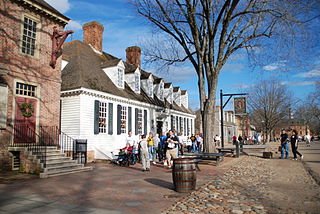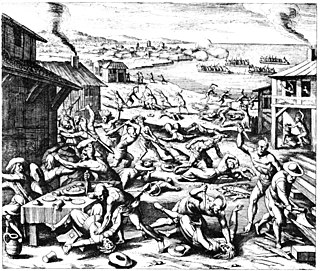Related Research Articles

The Jamestown settlement in the Colony of Virginia was the first permanent English settlement in the Americas. It was located on the northeast bank of the James River, about 2.5 mi (4 km) southwest of the center of modern Williamsburg. It was established by the Virginia Company of London as "James Fort" on May 4, 1607 O.S., and was considered permanent after a brief abandonment in 1610. It followed several failed attempts, including the Lost Colony of Roanoke, established in 1585 on Roanoke Island, later part of North Carolina. Jamestown served as the colonial capital from 1616 until 1699. Despite the dispatch of more settlers and supplies, more than 80 percent of the colonists died in 1609–1610, mostly from starvation and disease. In mid-1610, the survivors abandoned Jamestown, though they returned after meeting a resupply convoy in the James River.

Williamsburg is an independent city in Virginia, United States. As of the 2020 census, it had a population of 15,425. Located on the Virginia Peninsula, Williamsburg is in the northern part of the Hampton Roads metropolitan area. It is bordered by James City County on the west and south and York County on the east.

Thomas West, 3rd Baron De La Warr, was an English nobleman, for whom the bay, the river, and, consequently, a Native American people and U.S. state, all later called "Delaware", were named. A member of the House of Lords, from the death of his father in 1602 until his own death in 1618, he served as the governor of Virginia from 1610 to 1611.

The Colony of Virginia was an English, later British, colonial settlement in North America between 1606 and 1776.

The London Company, officially known as the Virginia Company of London, was a division of the Virginia Company with responsibility for colonizing the east coast of North America between latitudes 34° and 41° N.

The House of Burgesses was the elected representative element of the Virginia General Assembly, the legislative body of the Colony of Virginia.

The Virginia Company was an English trading company chartered by King James I on 10 April 1606 with the objective of colonizing the eastern coast of America. The coast was named Virginia, after Elizabeth I, and it stretched from present-day Maine to the Carolinas. The company's shareholders were Londoners, and it was distinguished from the Plymouth Company, which was chartered at the same time and composed largely of gentlemen from Plymouth, England.

Colonial Williamsburg is a living-history museum and private foundation presenting a part of the historic district in the city of Williamsburg, Virginia. Its 301-acre (122 ha) historic area includes several hundred restored or recreated buildings from the 18th century, when the city was the capital of the Colony of Virginia; 17th-century, 19th-century, and Colonial Revival structures; and more recent reconstructions. The historic area includes three main thoroughfares and their connecting side streets that attempt to suggest the atmosphere and the circumstances of 18th-century Americans. Costumed employees work and dress as people did in the era, sometimes using colonial grammar and diction.
Sir George Yeardley was a planter and colonial governor of the colony of Virginia. He was also among the first slaveowners in Colonial America. A survivor of the Virginia Company of London's ill-fated Third Supply Mission, whose flagship, the Sea Venture, was shipwrecked on Bermuda for ten months from 1609 to 1610, he is best remembered for presiding over the initial session of the first representative legislative body in Virginia in 1619. With representatives from throughout the settled portion of the colony, the group became known as the House of Burgesses. It has met continuously since, and is known in modern times as the Virginia General Assembly. Yeardley died in 1627.

The Honourable George Percy was an English explorer, author, and early Colonial Governor of Virginia.
Founded in 1889, the Association for the Preservation of Virginia Antiquities was the United States' first statewide historic preservation group. In 2003 the organization adopted the new name APVA Preservation Virginia to reflect a broader focus on statewide Preservation and in 2009 it shortened its name to Preservation Virginia. Preservation Virginia owns historic sites across Virginia including Historic Jamestowne, located at Jamestown, Virginia, site of the first permanent English settlement in North America, and the Cape Henry Light house, one of the first public works projects of the United States of America.

Sir Thomas Gates was the governor of Jamestown in the English Colony of Virginia. His predecessor, George Percy, through inept leadership, was responsible for the lives lost during the period called the Starving Time. The English-born Gates arrived to find a few surviving starving colonists commanded by Percy, and assumed command. Gates ruled with deputy governor Sir Thomas Dale. Their controlled, strict methods helped the early colonies survive. Sir Thomas was knighted in 1596 by Robert Devereux, 2nd Earl of Essex for gallantry at the Capture of Cadiz. His knighthood was later royally confirmed by Queen Elizabeth I.

The Anglo–Powhatan Wars were three wars fought between settlers of the Colony of Virginia and the Powhatan People of Tsenacommacah in the early 17th century. The first war started in 1609 and ended in a peace settlement in 1614. The second war lasted from 1622 to 1632. The third war lasted from 1644 until 1646 and ended when Opechancanough was captured and killed. That war resulted in a defined boundary between the Indians and colonial lands that could only be crossed for official business with a special pass. This situation lasted until 1677 and the Treaty of Middle Plantation which established Indian reservations following Bacon's Rebellion.
John Potts was a physician and Colonial Governor of Virginia at the Jamestown settlement in the Virginia Colony in the early 17th century.

Jamestown Church, constructed in brick from 1639 onward, in Jamestown in the Mid-Atlantic state of Virginia, is one of the oldest surviving building remnants built by Europeans in the original Thirteen Colonies and in the United States overall. It is now part of Historic Jamestown, and is owned by Preservation Virginia. There have been several sites and stages in the church's history, and its later tower is now the last surviving above-ground structure from the days when Jamestown was the capital of Virginia. The current structure, active as part of the Continuing Anglican movement, is still in use today. The ruins are currently being researched by members of the Jamestown Rediscovery project.
John Blair was a merchant and politician of the colony of Virginia. He served in both houses of the Virginia General Assembly. As a member of the House of Burgesses, he initially represented Jamestown then Williamsburg, before being appointed to the Governor's Council. There he served for more than 25 years, including four times becoming acting governor during changes of the royal governors and while governor Francis Fauquier was in the New York and Georgia colonies. Nonetheless, this John Blair, the earliest of the four men of the name serving in the Virginia General Assembly, may be best known either as the nephew and heir of Rev. James Blair or father of John Blair, Jr..

William Farrar was a landowner and politician in colonial Virginia. He was a subscriber to the third charter of the Virginia Company who immigrated to the colony from England in 1618. After surviving the Jamestown massacre of 1622, he moved to Jordan's Journey. In the following year, Farrar became involved in North America's first breach of promise suit when he proposed to Cecily Jordan.
Sir Richard Kemp was a planter and politician in the Colony of Virginia. Kemp served as the Colony's Secretary and on the Governor's Council from 1634 to 1649. As the council's senior member, he also served as the acting Colonial Governor of Virginia from 1644 to 1645 during travels by Governor Sir William Berkeley. Kemp had also worked closely relation with Berkeley's predecessor, Sir John Harvey.
Archibald Blair was a Scottish-born physician, merchant, planter and politician. Born in Roxburghshire, he moved to the English colony of Virginia in the 1690s. Blair served in the House of Burgesses multiple times, alternately representing the colony's capital and surrounding county. He may be confused with a distant collateral relative, Archibald Blair, who became clerk of the Virginia Governor's Council in 1776 and served for more than 25 years.
References
- ↑ Dary, David (2008). Frontier Medicine . Knopf. pp. 18. ISBN 9780307270313 . Retrieved 19 August 2015.
Lawrence Bohun.
- ↑ Wright, Louis B. (2002). The Cultural Life of the American Colonies. Dover Publications. p. 219. ISBN 9780486422237 . Retrieved 19 August 2015.
- ↑ Duffy, John. From Humors to Medical Science: A History of American Medicine By John Duffy. University of Illinois Press. 1993. p. 9. ISBN 9780252063008 . Retrieved 19 August 2015.
- ↑ Gill, Harold B. (1972). The Apothecary in Colonial Virginia . Colonial Williamsburg. pp. 16–17. ISBN 9780879350017 . Retrieved 19 August 2015.
Lawrence Bohun.
- ↑ Billings, Warren M. "Thomas West, twelfth baron De La Warr (1576–1618)". Encyclopedia Virginia. Retrieved 19 August 2015.
- ↑ Hughes, Thomas P. (1957). MEDICINE IN VIRGINIA, 1607-1699. Project Gutenberg. Retrieved 19 August 2015.
- ↑ The William and Mary Quarterly, Volume 14. William and Mary. 1906. p. 97. Retrieved 19 August 2015.
- ↑ Woodward, Hobson (2009). A Brave Vessel: The True Tale of the Castaways Who Rescued Jamestown. Penguin. ISBN 9781101060322 . Retrieved 19 August 2015.
- ↑ Toner, Joseph (1874). Medical Progress and Education: Before and during the war of Independence. Applewood Books. p. 8. ISBN 9781429043823 . Retrieved 19 August 2015.
- 1 2 Gentry, Daphne. "Lawrence Bohun (d. 1621)". Encyclopedia Virginia. Retrieved 19 August 2015.
- ↑ Gill, Harold B. (1972). The Apothecary in Colonial Virginia. Colonial Williamsburg Foundation/University Press of Virginia. p. 17. ISBN 0879350016 . Retrieved 19 August 2015.